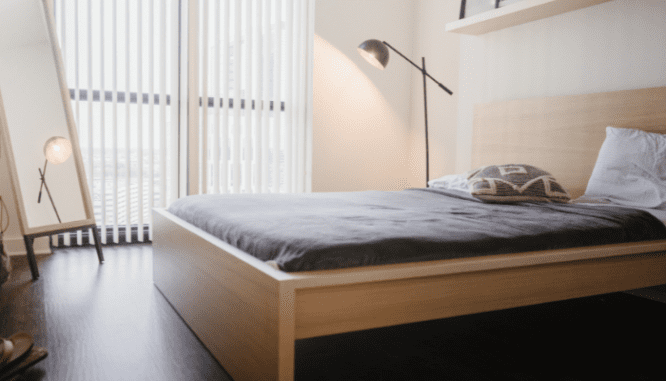Home Windows Need Replacement? Your Guide to the Installation Process
- Published on
- 10 min read
-
 Christine Bartsch Contributing AuthorClose
Christine Bartsch Contributing AuthorClose Christine Bartsch Contributing Author
Christine Bartsch Contributing AuthorFormer art and design instructor Christine Bartsch holds an MFA in creative writing from Spalding University. Launching her writing career in 2007, Christine has crafted interior design content for companies including USA Today and Houzz.
Your windows are acting stubborn and often stick. Wind whistles through gaps and cracks. You’re shocked by high energy bills. These are some of the main reasons you (and many homeowners) may decide to look into home window replacement.
New windows can improve energy efficiency and are easier to open and shut. Picture-perfect windows will also upgrade your home’s overall curb appeal. However, replacing your windows is a large project to tackle and an expensive one to boot.
The style and brand of windows you can afford — as well as the style and age of your house — can impact the way you go about replacing windows throughout the home. We’ve got the answers to all of the most frequently asked questions regarding home window replacement.

Signs that your home needs window replacements
Window replacement is a considerable investment of time and money, so it’s probably only worth the effort if your current windows are in disrepair. Here are the top signs that it’s time to upgrade your windows:
Detectable drafts
Only an open window should allow in outdoor air drafts, so if your closed windows allow drafts in, you may need window replacement.
You likely have a window draft if you hear whistling or feel air entering from the window frame. To further investigate, try the candle test.
On a windy day, turn off all nearby fans — including your HVAC system — and light a candle near the suspect window. Hold the candle as still as possible and look for any signs of flame movement caused by drafts seeping through the window. Pinpoint cracks and sealing issues by moving the flame around the window seams, both the pane and the frame.
If you only find a few sealing issues with the candle test, you may just need to replace the weather stripping to solve this issue. If there are significant sealing problems on multiple windows, it’s probably time to replace them.
Failing functionality
Latches that won’t catch, sashes that won’t slide, locks that don’t lock — all of these are signs you should repair or replace your windows.
Excessive moisture
Homeowners who suspect that their windows are failing should look for signs of interior moisture on rainy or snowy days. If a window is improperly sealed, moisture may pool on the sill, leading to wood rot and other moisture damage.
But don’t fret if there’s a little condensation — it’s normal to see condensation, and even frost, forming on the inside of your windows when your house is toasty warm inside, and it’s cool and damp outside.
Take steps to lower your condensation on the windows by opening heavy drapes, running a dehumidifier, or lowering the heat inside of your house. If that reduces the condensation, your windows are in good shape. Should you still see excessive condensation, then new windows may be the way to go.
Damaged frames or panes
It’s natural for window frames to become weathered over time. However, once the frames start to bend or the wood gets warped, it’s time to replace the windows.
It’s the same story when it comes to window panes. Many modern windows are made as one unit, meaning that a damaged window may only be replaceable instead of repairable. For example, should the glass panes break in a vinyl window that’s been soldered together, it may be too expensive to replace just the glass pane – you’ll need to replace the whole window.
Increased energy costs
When windows fail to keep the elements out, your energy costs increase. If you notice a sudden increase in your energy bills inconsistent with seasonal changes, check your windows for drafts and damage.

Window replacement cost overview
On average, homeowners pay around $650 per window replacement, which includes the cost of the window, labor, and materials. However, window replacement costs can range from $200 to $1,800 per window.
Window prices vary based on size, quality, and finish. For example, a small, single-hung window only costs around $170 per window to replace, whereas a large bay window will run you between $1,000 to $3,000 or more.
Window material also influences replacement cost. Aluminum and vinyl are the least expensive, while fiberglass and composite windows are the most expensive. However, with the soaring costs of lumber, wood windows are likely to rise in price.
Consider your home’s age before you buy new windows
Homes built before the 1940s have windows made from old growth wood, which have benefits over modern windows — even energy-efficient rated windows. Research shows that old growth wood windows in pre-1940s houses are actually just as energy efficient as modern energy-efficient rated windows, especially when you add a storm window to the historic windows.
“For historical homes, I recommend keeping the original windows instead of replacing them with double pane windows,” advises top real estate agent Hao Dang, who works with 76% more single-family homes in Seattle, Washington, than the average agent.
Old growth wood is harder and less porous than new growth wood, so it’s less susceptible to wood rot and decay. Old wood windows are composed of replaceable components, so they’re often relatively affordable to repair compared to new windows.
Furthermore, old growth windows may be ornate and architecturally detailed in the styles of their construction era, which adds a décor value to your house that modern windows simply cannot compete with.
“Preserving the original windows preserves the old world charm and character of historical homes,” Dang notes. “It simply doesn’t look right to have new windows on a home built in the 1880s or even up to the 1920s or ’30s.”
In any area where there are historic houses, there are repair and salvage companies that rescue old growth windows from historic homes that are being demolished or restored by homeowners replacing their windows. These historic window experts can help you determine if your old wood windows can be repaired or where to find replacements if necessary.

The window replacement process takes a few days
Professional window installers can replace all of your home’s windows in one to three days. How long the project takes depends on how many windows you have and whether or not your window openings need to be modified (made larger or smaller) to fit your new windows.
Here’s an overview of the window replacement project timeline:
Step 1: Pre-installation preparation
The day before your installation appointment, take down all window coverings (drapes, curtains, blinds, etc.), securely store all breakables and valuables, and move all furniture away from around the windows.
Cover any furniture that you can’t move with old sheets or tarps to protect them from construction dust and damage. You should also cover bushes and flower beds underneath your windows.
Window replacement is a loud and potentially dangerous construction project, so make arrangements to have kids and pets out of the house for the project’s duration.
Step 2: Installation day inspection
As soon as the installers arrive, inspect the new windows to ensure that they’ve brought the correct number and sizes of windows. You should also check the new windows for pre-existing damage.
Next, take the crew leader on a walkthrough of the house to give them instructions on where and how the windows need to be installed (especially if you are enlarging or reducing any window opening sizes). Provide any special instructions regarding furniture that’s remaining in place during the installation.
This is also the time to check in with the installers to verify who is responsible for the disposal of your old windows. Many installers include window disposal in the project cost.
Consider saving old historical windows
For homeowners replacing windows in a historic home, it’s wise to save those old windows rather than letting the installers dispose of them. Your unwanted old growth windows can be sold online or to a historic home salvager to help defray the cost of your new windows.
If you intend to keep your old windows, you need to make arrangements to ensure that they are removed with as little damage as possible and that they are not thrown away. Don’t assume that simply mentioning once that you want to keep the old windows is enough. Installers who are used to disposing of old windows may toss them out of habit.
Step 3: Step back and let the crew work
While it’s tempting to watch the installation with an eagle eye, this sort of hovering can lead to nervous mistakes or even resentment from the expert crew you’ve hired to get the job done.
Once you ensure that your installers have adequately prepared the site, it’s time to step back and let them work.
The actual process of installation varies depending on the type of window you’re having installed. For example, whole unit aluminum or vinyl windows may need to be fastened into place, then caulking, shims, flashing, and window trim are added to finish the window.
Step 4: Check in during installation if you’d like
Your biggest job during the pro installation itself is to keep yourself out of the installers’ way. However, it’s perfectly acceptable to check in from time to time to view the progress and ensure that your belongings are safe.
A midday check-in is an appropriate time to discuss the project timeline with the head installer. Ask if the team can complete the window replacement by the end of day or if they’ll need to return the next day.
Step 5: Final walkthrough
Once the new windows are all installed, ask the head installer to take a final walkthrough with you to ensure that the job is completed to your satisfaction. Check that the caulking and flashing are installed correctly, ask the installer to demonstrate that the windows are properly leveled, and ask them to review the installation and window warranties with you.
Here’s an overview of major retailer’s window installation costs
While your installation costs will vary greatly depending on your window type and the number of windows you’re having replaced, you can get a ballpark idea of how much the project will cost you by looking at the service costs and options of major brand window installers.
“Always opt for a reputable brand of windows that’s been around at least 20-plus years if possible,” Dang advises. “And choose windows that have a lifetime warranty that can be transferred from one owner to another. A transferable lifetime warranty on the windows is something you can advertise in your listing.”
Home Depot
Window installation through Home Depot begins with a free consultation on your replacement project, which can either be done in-home or virtually.
The design consultant will review your options, including window frame, glass type, and Energy Star rating. Your consultant will also measure your window openings to determine dimensions and provide you with a project quote. Home Depot’s quotes include the purchase, delivery, and installation of your new windows, as well as the free removal of your existing windows.
While Home Depot carries many brands and types of windows, they primarily deal with vinyl windows and wood windows. Vinyl windows run from $800 to $4,400 per window for full installation, while wood windows range from $1,000 to $7,900.
Lowe’s
Lowe’s also offers a complimentary virtual or on-site consultation. A project specialist will meet with you in your home to review your needs and advise what material and window types may work for your project.
The company has a wide variety of window styles, materials, and brands, and offers a price match guarantee.
Aluminum windows cost $35 to $428 per window; vinyl windows cost $32 to $312 per window; and wood windows cost $340 to $485 per window.
Menards
Menards offers a wide range of windows that include standard-sized and pre-designed windows, along with custom window options. Menards’ website has a helpful windows buying guide and instructional video on how to measure existing windows.
While Menards doesn’t offer window installation directly through their store, they do have an Installer Center to connect homeowners with local professionals free of charge. If you hire an independent contractor to do your window installations, you may need to measure your current windows and purchase the new windows in advance.

You don’t always need to remove siding to replace windows
Siding removal is an option but not a requirement for most window replacement projects. Whether or not siding needs to be removed depends largely on the condition of your existing exterior window frames. If you have standard-sized windows, or you work with a company that can retrofit windows, then you can insert new windows into the existing frames without touching the siding.
If the windows are damaged, or you are altering the window sizes from your existing windows, then you may need to remove or replace your siding. In some cases, you may be able to remove and replace the existing, damaged window casings without removing or replacing the siding.
DIY window replacement is not advisable
“Never DIY your window replacements because it’s a liability,” advises Dang. “There are a lot of things that can go wrong that will ruin your home’s value. A lot of times, the flashings are missing on DIY-installed windows, and they aren’t properly leveled, so you’ll see cracking in the window seals over time.”
Poorly installed windows can lead to high energy costs and water damage. Improper installation may even void the manufacturer warranty that comes with the windows.
Window replacement yields a fair return on investment
When you’re contemplating a project as big and expensive as window replacement, it’s only natural to wonder if new windows increase home value.
Thankfully, you can expect a solid return on investment for window replacement. For example, if you spend $12,000 to replace all of the windows in your house, you’ll likely see around a $9,000 increase in added value when you sell, which is an 81% ROI.
Plus, new energy-efficient, double pane windows are a huge selling feature — and not having them can actually hurt your home’s value in some markets.
“In Seattle, if a house has double pane windows, that’s definitely a feature that we highlight in our listings because buyers know that those windows will save them money over time,” explains Dang.
“However, new windows won’t really add anything to your home value. Buyers expect double pane windows, so not having them will detract from your home’s value. And windows in bad shape can negatively impact the price we list at, by as much as $25,000 to $60,000.”
Header Image Source: (Isaac Quesada / Unsplash)
